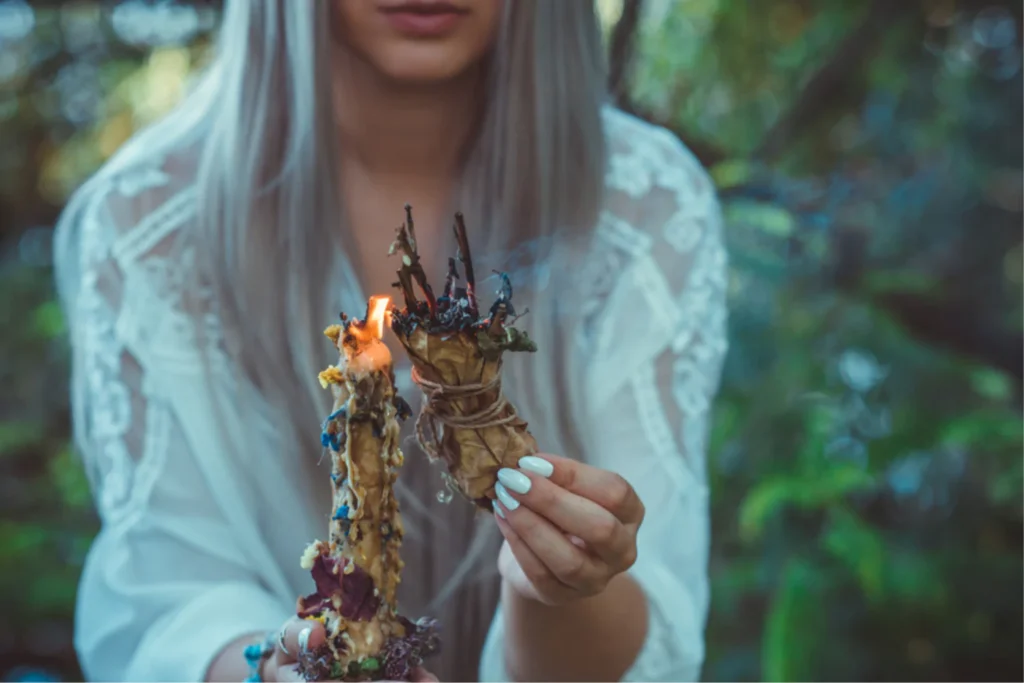What does the promises the religion of Wicca provide? How does it compare to the truth of God’s word?
Lauren presses send.
An incoherent string of emojis rises to the top of the comment section on her Instagram feed. What might appear as an innocent collection of symbols and shapes actually contains a latent meaning. Populating social media platforms like Tumblr, Instagram, and YouTube, these emoji strings represent the language of the rapid spread of online digital Wicca.
The ascent of digital witchcraft and Wicca has coincided with increased availability from internet platforms. Wiccans convene on the internet, amassing followings of young, aspiring witches.
How Has Wicca Grown?
The Gospel Coalition’s Joe Carter has noted that Wicca is the largest subset of the modern witchcraft revival movement, characterized as a “worldview, religion, and practices associated with using rituals that are believed to harness and focus cosmic or psychic energies to bring about some desired change. Modern witchcraft is the largest and most common subset of neo-paganism, a diverse group of religious movements that claim to be derived from historical pagan religions.”
Today, Wicca is aided by the entertainment industry’s infatuation with the supernatural. From Netflix’s The Chilling Adventures of Sabrina and to more subtle popularizations like ABC’s Once Upon a Time, the number of shows that glamorize magical practices has increased dramatically.
Wicca’s growing popularity can also be attributed to a rise in the younger generation’s interest in diverse social and natural issues such as climate change, gender equality, and LGBT rights. Wicca seems to offer answers for all these topics.
With so many touch points across media, politics, and culture, it’s not surprising that Wicca’s popularity is growing.
Seemingly Appealing Characteristics of Wicca
- Tolerance and Openness: Hashtags such as #mindfulness, #meditation, #spirituality, and #wellness connect Wiccans across social media platforms. A quick search will find overlap with areas of mysticism and tolerance found in corners of the LGBT community. In offering the promise of acceptance no matter who you are or what you do, Wicca especially appeals to younger teens who feel pressured to show “tolerance.”
Re-establish the Matriarchy: One of Wicca’s primary goals is to re-establish female power and usher in a new era of goddess worship. This is based in part on a flawed reimagining of history in which pre-Christian, ancient societies were matriarchal and utopian. Both Wicca and feminism share an overarching desire to replace male rule with female rule, effectively reversing gender roles rather than embracing a biblical view of men and women. Female power is viewed as not only necessary to escape the patriarchy, but intrinsic and natural.
- Emotional Highs: In appealing to younger teens, especially females, Wicca promises a safe medium to manage and heighten one’s emotions. Wiccans believe that connecting with nature enables them to both receive and give extensive healing and miracles. But what happens when you can’t replicate the same results every single time? These emotional highs ultimately are not grounded in universal, consistent truth.
- Influence Your Own Reality: The promise of being able to influence your reality sounds particularly appealing to teenagers who might otherwise feel powerless. Through incantations and rituals, Wicca promises an outlet for teens to manipulate power in the universe for their personal benefit. Unfortunately, as appealing as these offerings sound, they can lead down a path of self-destruction.
What Does Christianity Say?
- True Tolerance and Openness is Found in the Example of Jesus: Biblical tolerance clearly outlines that we are called to share God’s truth with others in gentleness and respect (1 Peter 3:15-16). Since God is a “God of truth,” we faithfully share His words in any environment. Secular tolerance draws its version of truth from the world. Biblical tolerance rests on the foundation of Jesus’ words: “I am the way and the truth and the life” (John 14:6). And it is Jesus who teaches us how to listen, respect, and love others well.
- The Matriarchy Diminishes the Importance of Each Person: The drive to place one gender as the “dominant” force in society is misguided. The distinction between male and female shows how both genders reflect the Creator; it does not tell us that one is greater or better than the other. In Ephesians 5:31-33, Paul highlights the equality of husband and wife in terms of each one’s personhood and value, while also illustrating their differences in function. God’s plans for men and women in the world point to the inherent value of both male and female, rather than enabling one over the other.
Jeremiah 17:9
- Emotional Highs: In Jeremiah 17:9, we read: “The heart is more deceitful than all things and desperately wicked; who can understand it?” This is especially true for those who do not trust in God’s gifts of grace and salvation. But this verse also serves as warning to believers, reminding us that our sinful nature can influence us negatively. However, in Psalm 73:26, we are encouraged with this truth: “My flesh and my heart fails, but God is the strength of my heart and my portion forever.” Our emotions can be unstable and will always fluctuate. Yet God is steadfast and stable, and we can rely on that truth.
What to do if Your Teen is Interested or Involved in Wicca
- Listen: The more questions you ask, the more room you will earn to speak. Ask your teen why they are interested. Seek to understand their perspective first through listening, and then use thoughtful questions that show genuine consideration.
- Find the “Why”: Research. Research. Research. Don’t be afraid to break the conversation up into separate smaller conversations after you’ve had some time to collect your thoughts. Teens appreciate well thought-out information. Feel free to call our Counseling Department for additional help.
- Talk: When you’re ready, offer your insight. Use some of the points above to help in your discussion. You are still the parent! Engage in a discussion outlining the biblical perspective on witchcraft and magic. Provide space for your teen to reason and think, both individually and alongside of you.
- The Eternal Power of God: Witchcraft has been around a long time. But its promises are empty. It can never offer eternal salvation or a relationship with Jesus Christ. For a Christian, there is no room for worship of anything but God. His promise of safety and salvation has always been better than anything Wicca or any other man-made religion has to offer.
Talk to a Counselor
If you need further guidance and encouragement, Focus on the Family has a staff of licensed, professional counselors who offer a one-time complimentary consultation from a Christian perspective. They can also refer you to counselors in your area for ongoing assistance.
Reach a Focus on the Family counselor toll-free at 1-855-771-HELP (4357).


